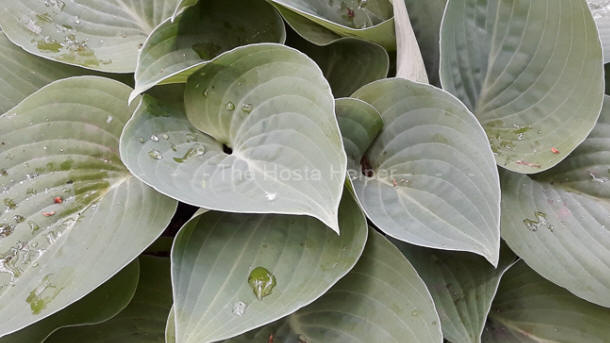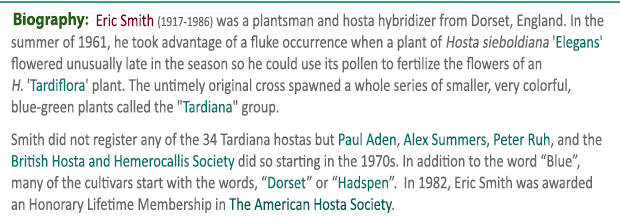
 This Tardiana-type hosta has
dark blue-green foliage of thick substance which was registered by
Paul Aden of New York on behalf of
English hybridizer,
Eric Smith in 1976. It forms a slow growing, small size plant about 10
inches high by 26 inches wide with foliage that starts the season
blue-green but changes to dark green as the season progresses. Near white flowers appear in July to
early August followed by viable seeds. This Tardiana-type hosta has
dark blue-green foliage of thick substance which was registered by
Paul Aden of New York on behalf of
English hybridizer,
Eric Smith in 1976. It forms a slow growing, small size plant about 10
inches high by 26 inches wide with foliage that starts the season
blue-green but changes to dark green as the season progresses. Near white flowers appear in July to
early August followed by viable seeds.
 According to
The Hosta Handbook by
Mark Zilis (2000), it was formerly known as 'TF
2 X 2" and, at one time, was also known as H. 'Halo' which is now a different cultivar. According to
The Hosta Handbook by
Mark Zilis (2000), it was formerly known as 'TF
2 X 2" and, at one time, was also known as H. 'Halo' which is now a different cultivar.
Mark Zilis (2009), says that "...'Blue Moon' has long been one of the
most popular of the Tardianas. The thick, heart-shaped, blue-green
foliage sets the standard for small-size, blue-green hostas. It has
also proven to be a good breeding plant, both as a pod and pollen
parent."


 An article by Warren I. Pollock in
The
Hosta Journal (1993 Vol. 24 No. 1) states that “The
problem is this: One or maybe more batches of
blue-leaved hostas were tissue cultured a few years
ago that were sold as ‘Blue Moon’ – but are not
Smith’s true ‘Blue Moon’. These hostas have leaves
considerably larger and more cupped that the true
Tardiana ‘Blue Moon’.…if you purchased a so-called
‘Blue Moon’ and the leaves are big and very cupped,
the petioles are fairly upright and it’s not of a
“fairly small” size. I must inform you of this. You
don’t have the true Tardiana ‘Blue Moon’.” An article by Warren I. Pollock in
The
Hosta Journal (1993 Vol. 24 No. 1) states that “The
problem is this: One or maybe more batches of
blue-leaved hostas were tissue cultured a few years
ago that were sold as ‘Blue Moon’ – but are not
Smith’s true ‘Blue Moon’. These hostas have leaves
considerably larger and more cupped that the true
Tardiana ‘Blue Moon’.…if you purchased a so-called
‘Blue Moon’ and the leaves are big and very cupped,
the petioles are fairly upright and it’s not of a
“fairly small” size. I must inform you of this. You
don’t have the true Tardiana ‘Blue Moon’.”
A Photo Essay article by Steve Chamberlain in
The
Hostta Journal (2010 Vol. 41 No. 1) makes comments about
H. 'Deep Blue Sea', "Charles Seaver registered this 'Blue Moon' seedling in
1994. My plant was a gift from Charlie at the Hostas in Focus Festival in 1997.
Early in the season this plant is an intense blue with extreme corrugation. By
the time it blooms later in the season, the wax has washed off and the leaves
are dark green and very shiny."







 |



